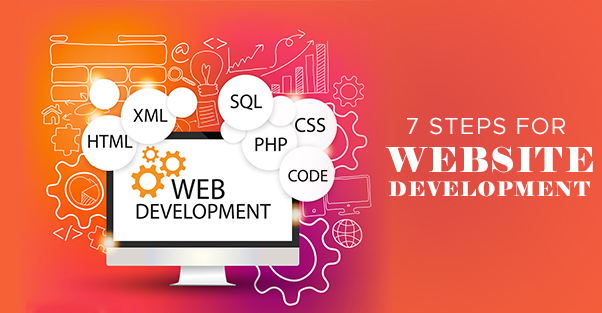The general notion of a website relies on the design quality of the website. The visuals and layouts are the key metrics that can either attract the users or they may find it unattractive. For this reason website development is one of the vital stages in making a fruitful online presence.
Every web development project has certain steps to follow from commencement to completion. These steps isolate the project into easily manageable stages. The specific phase of the web development process changes marginally but the most basic steps continue to be the same. In this blog we will discuss the 7 steps of Website development that generally work.
1. Project Planning:
To prepare the objectives and goals of the web development project is generally called project planning. This is probably the most important step in the whole project. It is divided into 5 following steps:
- Requirement analysis: To find out the proper requirement is the main objective of requirement analysis. In this step, the objective is to find out the website goals, target audience, detailed features and other related contents about the website.
- Project summary: Project summary is used to summarize the website’s requirements. The project summary is generally brief and this serves as references throughout the entire web development project.
- Determination of required resources: In the project planning section, software and other resources to make the website project is included. The main criteria of this stage is to recognize any third-party media requirements. The resources that will be necessary in order to make the website is accordingly added to the budget of the entire project.
- Main performance objectives: Budgeted costs, page speed and project deadlines are some of the objectives of this segment. Development goals and the website design are being set at this stage.
- Assessment of the contenders: To find out the rivals of your business is the key motto of this stage. How many people will visit your website? What will be the bounce rate? And other vital things like visual branding, navigation, layout etc. are projected in this section.
2. Determination Of Project Scope:
Creating a well-explained plan about the project ends on time and within the budget is the main motto of this segment. It can be projected through a Gantt chart also. Gantt chart is a model that shows the timeline for completing each step.
3. Website Design:
This step is probably the most critical part in the entire project. To select colour, theme, features and layout of the website is the prime motto of this step. In this stage, the website developer includes a number of elements including colour that enhances the brand identity, logo of the company, a suitable theme that matches the portfolio of the company etc.
The designer then creates multiple prototypes and sends them accordingly to the client via email. If you are a resident of Surat, you can always find a website designer in Surat for designing your website and website development in Surat for developing your website as well.
4. Website Development:
In this segment, the developer uses the individual elements of the projected website to build a functional website. The home page is created in this segment, then a shell is created for the interior tabs. The shell mainly contains the site layout and the navigational structure excluding the web contents. After the client gives the developer the needed contents, the developer then distributes all the contents throughout the site in the specific areas.
5. Testing and Publishing The Website:
In this phase the website designer supplements final touches to the site and thorough tests are done before launching the site to avoid any unwanted glitches.
The designer will entirely test every aspect like forums and scripts to make sure the website displays every link and does every job perfectly on different platforms and devices.
Then the website is shown to the client for any final changes that are required and delivered to the client after fixing. Then it is uploaded on the hosting server selected and specified by the client through FTP (File Transfer Protocol).
Then finally the website development team includes some finer details to help the website to perform smoothly by adding SEO (Search Engine Optimization), and optimization of the page speed. To know more about Search Engine Optimization services you can visit this SEO company services surat.
6. Creating Content:
This process attracts the readers and helps them to take action accordingly; therefore the pattern of the content is very important to reach more audiences.
Writers should circumvent long, boring contents which can fail to catch visitors. The content should be short, concise and interesting for attracting more audiences. If the page needs larger content then try to use visuals to make it more appealing. The contents are the main reason to be visible in the search engine results.
7. Visuals:
In the website design, the images hold a huge role in engaging more audience by giving a professional feel and look. Images can also assist you to build trust for your brand. Images make the writings on the website easier and supplements the strength of the texts. Apt images can help to convey the messages that are written in texts. The more clicks on your images or content, the more you collect the revenue this is mainly what content is known for.
Keep in mind, using large images can slow down the operational speed of your website, use image compressing tools to upload large images for lesser size.
